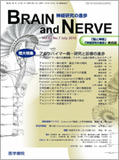Japanese
English
- 有料閲覧
- Abstract 文献概要
- 1ページ目 Look Inside
- 参考文献 Reference
はじめに
Posterior cortical atrophy(PCA)は,視空間機能の障害を主徴とした変性疾患の総称である。これは1988年にBensonら1)が,大脳後方の萎縮とともにGerstmann症候群,Balint症候群,超皮質性感覚性失語などの機能低下を示す一方で,記憶障害や病識の低下がみられないなどの共通の特徴を示す5症例を記述する際に提唱された概念である。提唱された当初からアルツハイマー病(Alzheimer disease:AD)との相違や,疾患や症候の独自性に疑問が持たれていたが2),その後の検討によって,その多くはADを病理学的な背景とすることが明らかとなった3-7)。しかし,症候8),形態9),病変の分布4)において,典型的なADとは異なった病態である。
なおPCAという用語以外にも,病変をより限局的に表現するprogressive biparietal atrophy10)や,早期には萎縮が明らかではないため,progressive posterior cortical dysfunction3,5),posterior cortical dementia11)などの用語が用いられることもある。また,視覚変異型AD(visual variant of Alzheimer's disease)と言い換えられることも多いが,剖検がなされない限りはADの診断が難しいことから,そのような表現には慎重な立場もある3)。
Abstract
Posterior cortical atrophy (PCA) is a degenerative disease characterized by posterior cortical dysfunction,e. g. Bálint syndrome and Gerstmann syndrome; however insight and memory are preserved. The most common neuropsychological symptoms seen in these patients are full blown Bálint syndrome or some components of the syndrome. These patients behave differently from patients with stroke or traumatic injury. Patients with PCA manifesting as severe Bálint syndrome,are almost blind except that they can walk without colliding with obstacles; in contrast patients with stroke or traumatic injury manifesting as Bálint syndrome collide with obstacles. Although a number of studies have reported pathological backgrounds other than Alzheimer disease (AD) in patients with PCA. AD is the most common pathological background observed in such patients. The neuropsychological,morphological,and pathological profiles of patients with PCA differ from those of patients with typical AD. Recently,neuropsychological and pathological studies have reported cognitive diversity in patients with AD; PCA is a variant form of AD. Although the classification of PCAs into different categories might have little value with regard to pharmaceutical therapy,such information is important with regard to the care and support of patients with PCA.

Copyright © 2010, Igaku-Shoin Ltd. All rights reserved.


